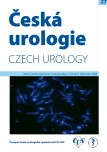Long-term follow-up of living kidney donors – a single center experience
Authors:
Michaela Matysková Kubišová 1,2; Jaroslav Pacovský 2,3; Pavel Navrátil jr. 2,3; Roman Šafránek 1,2; Pavel Navrátil 2,3; Igor Guňka 2,4; Sylvie Dusilová Sulková 1,2
Authors‘ workplace:
Nefrologická klinika Fakultní nemocnice Hradec Králové a LF UK
1; Mezioborové transplantační centrum Fakultní nemocnice Hradec Králové a LF UK
2; Urologická klinika Fakultní nemocnice Hradec Králové a LF UK
3; Chirurgická klinika Fakultní nemocnice Hradec Králové a LF UK
4
Published in:
Ces Urol 2023; 27(2): 101-108
Category:
Original article
Overview
Aim: The main condition for kidney transplants from a living donor is to ensure the donor‘s safety and exclude donation under duress. The aim of our work is to try to describe the risks arising from donation in the context of the current perspective, data from large sets of donors and control groups and describe our own results.
Patients and methods: 56 pairs were enrolled in the retrospective study. The results of the donor were mainly monitored – serum creatinine values, the occurrence of arterial hypertension or diabetes after donation, the effect of smoking on the further fate of the donor and eventual cause of donor death. In the recipient, serum creatinine values and possibly the cause of graft failure.
Results: In our group of donors we register 40 females (71%) and 16 males (29%). The median creatinine level at 5 years after donation is 93 umol /l. None of the living kidney donors developed terminal renal failure during the study period. Pharmacologically compensated arterial hypertension occurred in 29% of donors prior to kidney donation and in the monitored period after transplanation the number of donors with proven arterial hypertension increased to 50%. 43 donors (77%) were non – smokers before surgery and 13 donors (23%) smoked. In our group, the association with smoking history and function of the native kidney was not proven (median creatinine at 5 years after donation in non – smokers 94.5 umol/l, in smokers 82 umol /l). In the study period, 18 graft failures were confirmed, with a median graft function duration of 65 months and a median level of 5 – year creatinine in recipients of 121 umol/l. In seven cases (13% of recipients), the recipient with a functional graft died from another serious comorbidity.
Conclusion: Kidney transplantation from a living donor is a highly effective method of treating renal failure, which has a better success rate compared to transplantation from a deceased donor. A potential living kidney donor must be carefully investigated and given detailed information on the potential risks arising from kidney donation.
Keywords:
long-term results – kidney transplantation – living donors.
Sources
1. Viklický O. Transplantace ledviny od žijících dárců – jak doporučení KDIGO 2017 ovlivňují naší praxi? Postgraduální nefrologie. 2020; 18(3): 3–9.
2. Kidney Disease: Improving Global Outcomes (KDIGO) Living Kidney Donor Work Group. KDIGO clinical practice guideline on the evaluation and followup care of living kidney donors. Transplantation. 2017; 101(Suppl. 8S): S1–S109.
3. Pacovský J, Navrátil P, Holub L, Broďák M, Romžová M. Chirurgické techniky transplantace ledviny. Urol List. 2009; 7(1).
4. Ibrahim HN, Foley R, Tan L, et al. Long‑term consequences of kidney donation. N Engl J Med. 2009; 360: 459–469.
5. Muzaale AD, Massie AB, Wang MCh, et al. Risk of End‑Stage Renal Disease Following Live Kidney Donation. JAMA. 2014; 311(6): 579–586.
6. Lentine KL, Schnitzler MA, Xiao H, et al. Racial variation in medical outcomes among living kidney donors. N Engl J Med. 2010; 363: 724–732.
7. Wainright JL, Robinson AM, Wilk AR, et al. Risk of ESRD in prior living kidney donors. Am J Transplant. 2018; 18(5): 1129–1139.
8. Segev DL, Muzaale AD, Caffo BS, et al. Perioperative mortality and long‑term survival following live kidney donation. JAMA. 2010; 303: 959–966.
9. Tent H, Sanders J‑SF, Rook M, et al. Effects of preexistent hypertension on blood pressure and residual renal function after donor nephrectomy. Transplantation. 2012; 93: 412–417.
10. Nagasawa Y, Yamamoto R, Rakugi H, Isaka Y. Cigarette smoking and chronic kidney diseases. Hypertens Res. 2012; 35: 261–265.
11. Roodnat JI, van Riemsdijk IC, Mulder PGH, et al. The superior results of living‑donor renal transplantation are not completely caused by selection or short cold ischemia time: A single‑center, multivariate analysis. Transplantation. 2003; 75: 2014.
12. Oien CM, Reisaeter AV, Leivestad T, et al. Living donor kidney transplantation: The effects of donor age and gender on short- and long‑term outcomes. Transplantation. 2007; 83: 600.
13. Gill J, Bunnapradist S, Danovitch GM, et al. Outcomes of kidney transplantation from older living donors to older recipients. Am J Kidney, DiS. 2008; 52: 541.
14. Viklický O. Kalkulátor rizika selhání ledvin pro žijící dárce ledviny. Postgraduální nefrologie. 2015; 13(4): 64–66.
Labels
Paediatric urologist Nephrology UrologyArticle was published in
Czech Urology

2023 Issue 2
Most read in this issue
- Prognostic factors in metastatic prostate cancer
- 5th edition of the 2022 WHO classification of prostate cancer: changes and novelties in the "Blue Book"
- Early complications after radical cystectomy before implementation of the ERAS concept (Enhanced Recovery After Surgery)
- The results of percutaneous nephrostomy tube placement under ultrasound guidance
